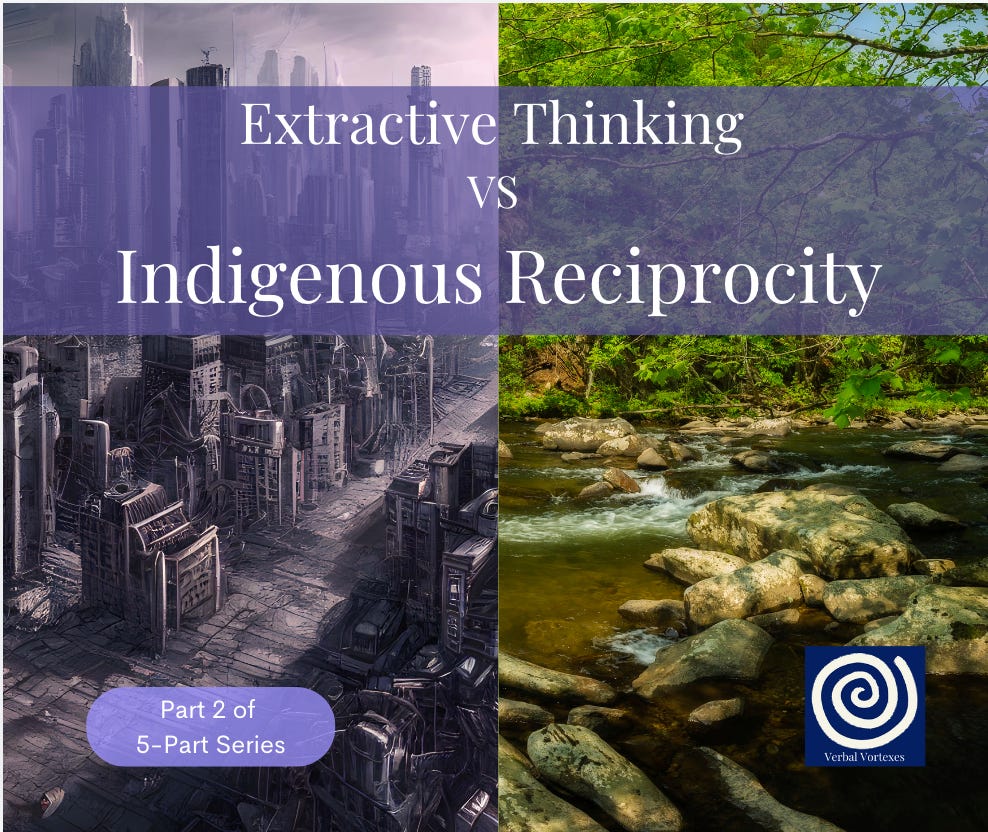The Indigenous Circle: A Framework of Balance #2 Extractive Thinking Series
Reclaiming Harmony Through An Indigenous Lens
The Indigenous Circle: A Deep Dive into Balance and Reciprocity
The Indigenous circle is more than a symbol; it represents an intricate and sacred framework of balance, reciprocity, and interconnectedness, deeply rooted in many Indigenous cultures around the world.
This worldview is anchored in the belief that all beings—whether trees, animals, water, rocks, plants, humans, or birds—hold equal value within the web of life. It emphasizes the cyclical nature of existence, where every living and non-living element plays a critical role in maintaining balance and harmony.
In stark contrast to the hierarchies and exploitation inherent in extractive thinking, the Indigenous circle offers us a way of being that fosters sustainability, empathy, and a profound respect for all beings. Let’s break down some of the key elements of this worldview:
1. Interconnectedness
At the core of the Indigenous circle is the belief that all life forms are interdependent. Every being—from the smallest insect to the largest tree—has a unique role and purpose within the ecosystem. This interconnectedness is what shapes and sustains the web of life, reminding us that the well-being of one is tied to the well-being of all. The harm inflicted on one part of the circle ripples out, affecting the whole.
Example: In many Indigenous cultures, the relationship between humans and the environment is one of deep reciprocity. In some traditions, when harvesting plants or hunting, a prayer of gratitude is given, acknowledging the life being taken and promising to care for the earth in return.
2. Balance and Harmony
The Indigenous circle teaches that balance is essential to the health of the natural world. Unlike extractive thinking, which values endless consumption and growth, Indigenous worldviews emphasize equilibrium. This means recognizing the limits of nature and respecting those boundaries to prevent depletion and destruction.
Example: Traditional agricultural practices, such as crop rotation or leaving land fallow, are rooted in the idea of balance, ensuring that the earth can replenish itself rather than be exhausted by overuse.
3. Reciprocity and Respect
Respect is foundational in the Indigenous circle. All beings are seen as possessing inherent rights and value. This respect manifests in the practice of reciprocity—giving back to the land, animals, and elements that provide for us. In contrast, extractive thinking takes without giving back, creating an imbalance that ultimately leads to harm for both humans and nature.
Example: In Cherokee culture, the relationship with water is one of reverence. Water is considered a living entity, and special ceremonies are performed to honor and thank water for its role in sustaining life. This practice contrasts sharply with modern systems that often see water as a commodity to be exploited.
You’ve read the first half of part 2 of a 5-part series
How will we approach »»» Reclaiming Balance and who is willing to face the consequences of extractive thinking in a world of shared resources?
This is a 5 part series for Leaders + Learners where you and I take an honest look at “What is Extractive Thinking?”
Here is a succinct outline of what you can expect in this first of five posts in this series here on Verbal Vortexes.
Thank you for joining me and my mind-heart-gut approach to where we can do the work both internally (with our inner game) and externally (our expression the outer game)
What’s Extraction
The Indigenous Circle: A Framework for Balance
Consequences of Extractive Thinking
Extractive Thinking in Leadership
Restoring the Balance: Lessons from Indigenous Wisdom
Practical Action + Conclusion
A gentle reminder, this body of work you are reading and listening to here on Verbal Vortexes is produced from Dyslexic Thinking. What do you know or remember learning with me about Dyslexic Thinking?
Share with me in the comments below.
RESTORATION IN ACTION
Part of restoration is recognizing and paying for emotional and intellectual labor instead of only honoring physical labor.
The first in this series is free. You can read it here.
You are asked to become a paid member to access the rest of this post and the rest of the series.
Those who honor and take action to rebalance reciprocity are appreciated.
P.S. Founder Members receive a 1-on-1 session with me and all my written guides + workbooks.
Keep reading with a 7-day free trial
Subscribe to Leadership Revealed by Verbal Vortexes to keep reading this post and get 7 days of free access to the full post archives.






